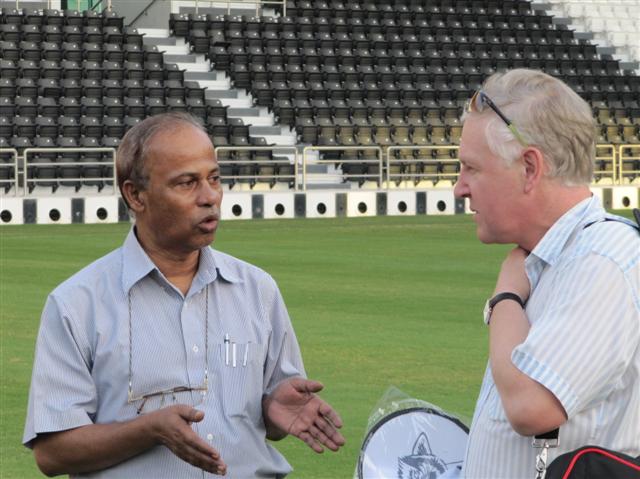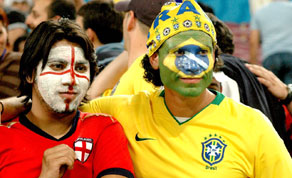“It was desert in July 2003.”
The Aspire academy for sports excellence – along with the city-centre skyline – is perhaps the most dramatic illustration of the pace at which Doha is changing.
Six years ago, as our guide said, it was desert.
Today, the site boasts not just a sports school with a growing international reputation, but a mind-boggling cluster of indoor sports venues.
In front of us is an immaculate basketball court; along the way, the athletics arena that will host the 2010 World Indoor Athletics Championships.
A few steps more, and you stumble upon a full-sized artificial turf football ground with a seating capacity of 6,000, not to mention an Olympic-sized swimming pool.
Oh and not forgetting the fencing area, where athletes competing in the Asian Championship were warming up as we looked on.
Altogether an astonishing 13 different sporting events could be hosted simultaneously under one roof – the largest dome of its kind in the world.
Everywhere on the walls are reminders of the iconic sports stars that the kids who come here, yes, Aspire to be: a Hicham El Guerrouj running vest here; a pair of Ronaldinho’s football boots there.
One wall of the basketball area is inscribed with a quotation from – who else? – Michael Jordan.
“I’ve failed over and over and over again in my life,” the spring-heeled one is quoted as saying. “And that is why I succeed.”
According to our guide, international football teams come every week to this ultra-modern institution that could almost have been inspired by the hit movie Fame (only with balls replacing dance-steps). This week it is RSC Anderlecht and the Senegal Under-17s.
I have just returned from a trip to Qatar as a guest of the Qatar 2022 World Cup bid.
There is, of course, a limit to the amount of knowledge one can acquire about a country in the course of a 42-hour stay.
But even this limited time has been enough to erase any residual doubts I might have had about the capability of this arid peninsula, located about halfway down the east coast of Saudi Arabia, to host a World Cup.
I think a Qatari World Cup would be a surreal experience.
But frankly, attending this self-important quadrennial glorification of the round ball is a surreal experience wherever it is plonked down.
Let’s try and tick off some of the salient issues one by one.
1. Heat
It is bakingly hot here, as I can testify after about 30 seconds in the open at the Aspire car park at 11.15am – and November is by no means the hottest month.
However, the country is ploughing a lot of resources into developing cooling technology that would air-condition large areas such as fan-zones, as well as the actual stadia.
We were given an insight into the current state of this technology on a visit to the 14,000-capacity Al Sadd stadium, home of a Qatari club team where the former Middlesbrough striker Afonso Alves now plays.
It is a lavishly fitted-out venue whose pièce de résistance are the lines of vents, both around the pitch and under spectators’ seats, which pump out cool air, reducing the temperature to well below that prevailing outside.
It was a comfortable afternoon for our visit, so we perhaps didn’t experience the system’s effects to best advantage.
 But during a brief conversation with an engineer, I was given to understand that a) the maximum difference in temperature vis à vis the outside world so far achieved is 17°C – 21° versus 38°; and b) the cost of a new system – I think he meant a new second-generation system rather than the one installed at Al Sadd – would be about $20 million and the running costs about $2,000 an hour.
But during a brief conversation with an engineer, I was given to understand that a) the maximum difference in temperature vis à vis the outside world so far achieved is 17°C – 21° versus 38°; and b) the cost of a new system – I think he meant a new second-generation system rather than the one installed at Al Sadd – would be about $20 million and the running costs about $2,000 an hour.
My interlocutors also indicated that the system was not really expected to allow football to be played in the blistering heat of the midday desert sun.
I am not therefore convinced that 3pm kick-offs would be a good idea if the World Cup came here – unless the stadia used were indoors – but 5pm should be quite feasible.
It would still be hot outside, of course, which, if nothing else, should be a significant help with policing.
Visiting fans would, as far as I can see, have little choice but to hop from one air-conditioned sanctuary to another, making their movements rather predictable.
They would simply not be able to roam the streets looking for trouble.
It was also put to me that Qatar might propose a start-date slightly earlier in June than is usual, the suggestion being that temperatures tend to be marginally cooler at the start of that month.
Though both the 1986 and 2002 World Cups kicked off on May 31, I am not sure that this would be the best of ideas, since it would give Europe-based players – ie nearly all the big names – less time to recover from a punishing club season.
2. Size
Yes, it’s a pinhead on the map, but when you come here you realise that Qatar is not as small as all that – I’d guess it’s a similar size to Corsica.
I don’t doubt that by 2022 it could accommodate 32 teams and their fans, albeit some of them in very close proximity.
And while you might think traffic could be an issue, the country’s national plan to the year 2030 apparently calls for construction of a comprehensive train and subway system.
It would be different to other World Cups in that teams and spectators would presumably stay in the same places for up to a month, rather than peregrinating around the country by Deutsche Bahn or Shinkansen.
As a journalist, though, I have to say I can see the attraction of that.
Of course those England fans who habitually use their footballing trips to visit, say, the Louvre’s Etruscan antiquities or the finest Venetian churches might regret the relative shortage of historical monuments. Much of Doha’s modern architecture, though, is stunning.
I do think there is a risk of white elephants, since it is hard to imagine a country of Qatar’s size really needing 12 World Cup-calibre stadia.
However, I am assured that plans to prevent this are in hand, with options including, in some cases, dismantling venues and giving them to other, presumably poorer, countries.
3. Alcohol

To judge by the St George cross banners unfurled near the poolside bar of the Doha Intercontinental on the morning of the England v Brazil game, I doubt that absence of alcohol would be high on England fans’ lists of complaints about their trip.
(A toothless display by their team, on the other hand, probably would be.)
So far as I can assess, Qatari society has come to accept, if not necessarily embrace, the alcohol-fuelled social lives of some of the many foreigners lured here – from as far afield as Manila and Myanmar – by the pace of the country’s gas-fuelled development.
From McDonald’s restaurants to Carrefour hypermarkets, Doha does seem to have most of the trappings of a consumerist western-style society.
The catering contract at the Khalifa Stadium is currently held by Fauchon, that magnet for epicures in Paris’s ultra-chic Place de la Madeleine, for goodness sake.
That is not to say there are not moments when glimpses of a more traditional Islamic society don’t jump out.
I was struck, for example, that Pixie Lott was climbing the Doha Top 40; but I was even more struck – thankful but definitely struck – when the local radio station abruptly interrupted her song to broadcast “the evening call to prayer”.
Another example – at Aspire, the swimming-pool was shuttered off because, our guide said, a female training session was in progress.
I suspect there is still tension between modernisers and traditionalists in this society.
And making a commitment to stage a tournament nearly 13 years into the future in a country just across the Persian Gulf from Iran is unlikely ever to be an entirely risk-free proposition.
For the moment, though, to all outside appearances, Qatar’s modernisers seem to have the country pretty firmly in their grip.
I am not saying that Qatar will win the right to stage the 2022 World Cup.
The field is immensely strong; the 24-man FIFA Executive Committee moves in mysterious ways.
But that it could stage the 2022 World Cup, if the current hot pace of development continues, I have no doubt.
David Owen is a specialist sports journalist who worked for 20 years for the Financial Times in the United States, Canada, France and the UK. He ended his FT career as sports editor after the 2006 World Cup and is now freelancing, including covering last year’s Beijing Olympics. An archive of Owen’s material may be found by Twitter users at www.twitter.com/dodo938.
